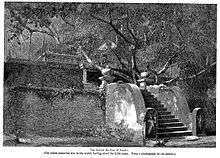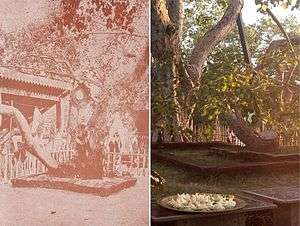Jaya Sri Maha Bodhi
Coordinates: 8°20′41″N 80°23′48″E / 8.34472°N 80.39667°E
| Jaya Sri Maha Bodhi ජය ශ්රී මහා බොධිය | |
|---|---|
|
Sacred Bodhi before c.1913 and in Recent Past. | |
| Species | F. religiosa (Ficus religiosa) |
| Location | Anuradhapura, Sri Lanka |
| Date seeded | 288 BC (Planted) |
| Custodian | Mahavihara of Anuradhapura |
Jaya Sri Maha Bodhi (Sinhala: ජය ශ්රී මහා බොධිය) is a Sacred Fig tree in the Mahamewna Gardens, Anuradhapura, Sri Lanka. It is said to be the right-wing branch (southern branch) from the historical Sri Maha Bodhi at Buddha Gaya in India under which Lord Buddha attained Enlightenment. It was planted in 249 BC,[1][2][3] and is the oldest living human-planted tree in the world with a known planting date.[4] Today it is one of the most sacred relics of the Buddhists in Sri Lanka and respected by Buddhists all over the world.
The other fig trees that surround the sacred tree protect it from storms and animals such as monkeys, bats, etc.
In April 2014, the government banned all construction within 500 meters of the tree. Only construction that obviously will not harm the tree will be allowed.[5]
Religious and social significance of the Jaya Sri Maha Bodhi
Buddhists in the Island have had a practice of visiting and paying homage to the most sacred Bodhi tree since time immemorial. It is an annual custom for pilgrims from far-away villages to visit the city of Anuradhapura and to pay homage to the Sri Maha Bodhi. The caretaker of this site provides various offerings on a daily basis since time immemorial. The Buddhists in general have a strong belief that offerings made to the Jaya Sri Maha Bodhi have produced significant and positive changes in their life. It has also been customary for many Buddhists to make a special vow before the Jaya Sri Maha Bodhi for the safe delivery of their babies without malformations, to cure various ailments and for many other cures. It has also been a long tradition among farmers around Anuradhapura to offer the Sri Maha Bodhi tree the rice prepared from their first paddy harvest. They strongly believe that such offerings lead to a sustained paddy production with the least sufferings from drought, pest attacks including elephant damage.
History

In the 3rd century BC, it was brought to Sri Lanka by Sangamitta (Pali; Skt.: Sanghamitra) Thera, the daughter of Emperor Asoka and founder of an order of Buddhist nuns in Sri Lanka. In 288 BC [6][7][8][9] it was planted by King Devanampiya Tissa on a high terrace about 6.5 m (21.3 ft) above the ground in the Mahamevnāwa Park in Anuradhapura and surrounded by railings.
Contributions
Several ancient kings have contributed in developing this religious site. King Vasabha (65 - 107 AD) placed four Buddha statues in four side of the sacred tree. King Voharika Tissa (214 - 236 AD) added metallic statues. King Mahanaga (569 - 571 AD) constructed a water canal around the sacred tree and King Sena II (846 - 866 AD) renovated it.[10]
The present wall was constructed by Ilupandeniye Athtadassi Thero during the reign of King Kirti Sri Rajasinha, to protect it from wild elephants which might have damaged the tree. The height of the wall is 10 ft (3.0 m); and 5 ft (1.5 m) in thickness; its length from north to south is 388 ft (118.3 m) and from east to west 274 ft (83.5 m).
The first golden fence around the sacred tree was constructed by some Buddhist followers in Kandy under the guidance of Yatirawana Narada Thero in 1969. The iron fence below the above golden fence was created by people of Gonagala under the guidance of Yagirala Pannananda Thero.
Ancient models
Two statues of Lord Buddha can be seen in the image-house; a stone-standing-statue is in the right side of the stone wall. The cobra-stone is a very rare creation, showing the embossed figure of cobra. Several monolith heads with plain incisions are in this religious site.
Discoveries

Ruins of an ancient building called Mayura Pirivena (Mayura Monastery) have been found to the south-west of the Jaya Sri Maha Bodhi, and the ruins of a stupa called Dakkhina Tupa (Southern Monastery) can be seen nearby.
According to the ancient chronicles in Sri Lanka, some walls and terraces had been built surrounding the sacred tree at some time in the past. Mahavamsa states that King Gothabhaya (249 – 262 AD) built a rubble wall. Dipavamsa reports that a rock-laid terrace and a lattice wall was built by King Kirthi Sri Meghavarna (302 - 330 AD).
During excavation for reconstructing the present wall, the rubble wall with its foundation created by King Gotabhya, and the rock-laid terrace together with a lattice wall constructed by King Kirthi Sri Meghavarna were found. These were preserved at place, and were opened to public in January 2010.
Incidents
Two branches of the sacred tree were broken during separate storms in 1907 and 1911. An individual cut down a branch in 1929. Tamil Tiger separatists shot and massacred a number of Sinhales-Buddhists on the upper terrace in 1985. This incident is known as the Anuradhapura massacre.[10]
See also
References
- ↑ Shanika Sriyananda (2011-07-03). "Caring for the Jaya Sri Maha Bodhi ". Retrieved 2013-05-08.
- ↑ Weerakoon, Rajitha (11 December 2011). "Sanghamitta Theri forged the liberation of Lankan women". SundayTimes. Retrieved 9 May 2013.
- ↑ Pelpola, Charith (16 August 1998). "Oldest sacred symbol". SundayTimes. Retrieved 9 May 2013.
- ↑ "The Coming of the Bodhi Tree to Lanka". Retrieved 2013-05-08.
- ↑ http://www.dailynews.lk/?q=local/all-constructions-within-500-m-jaya-sri-maha-bodhi-precinct-be-halted
- ↑ "19: The Coming of the Bodhi-Tree". Mahavamsa. Retrieved 9 May 2013.
- ↑ Sarathchandra, Vimukthi (1 December 2009). "Arrival of the Bo-tree sapling". DailyNews. Retrieved 9 May 2013.
- ↑ Wickramage, Florence (25 April 2002). "Mahamevuna Royal Gardens to regain ancient glory". DailyNews. Retrieved 9 May 2013.
- ↑ "Then and now, spreading its sacredness worldwide". SundayTimes. 20 February 2011. Retrieved 9 May 2013.
- 1 2 Kulatunga, Prof. T. G. (2003). "1". Anuradhapura Atamasthanaya (in Sinhala). Maharagama: Tarangi Prints. pp. 8–9.
External links
| Wikimedia Commons has media related to Jaya Sri Maha Bodhi. |
- Discover Sri Lanka - more information & images about Sri Maha Bodhi
- Living Heritage - Jaya Siri Maha Bodhi
- UNESCO World Heritage - Sacred City of Anuradhapura
- Sri Maha Bodhi tourist site
- The Bodhi Tree Network - Listing of branches/saplings of the Bodhi Tree around the world, cultivation tips of Bo tree, and how to share Bodhi trees
- Buddha and the Bodhi tree

